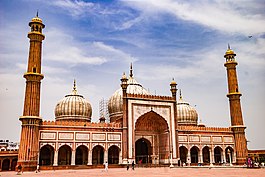Jama Masjid (Delhi)
| Jama Masjid | |
|---|---|
 |
|
| Basic information | |
| Location | Central Delhi, Delhi, India |
| Geographic coordinates | 28°39′03″N 77°14′00″E / 28.6507°N 77.2334°ECoordinates: 28°39′03″N 77°14′00″E / 28.6507°N 77.2334°E |
| Affiliation | Islam |
| Branch/tradition | Hanafi Deobandi |
| Country | India |
| Leadership |
Shahi Imam : Syed Ahmed Bukhari |
| Architectural description | |
| Architectural type | Mosque |
| Architectural style | Islamic |
| Date established | 1656 |
| Specifications | |
| Capacity | 25,000 |
| Length | 40 metres (130 ft) |
| Width | 27 metres (89 ft) |
| Dome(s) | 3 |
| Minaret(s) | 2 |
| Minaret height | 41 metres (135 ft) |
| Materials | Red sandstone, marble |
The Masjid-i Jahān-Numā (World-reflecting Mosque), commonly known as the Jama Masjid of Delhi, is one of the largest mosques in India.
It was built by Mughal emperor Shah Jahan between 1644 and 1656 at a cost of 1 million rupees, and was inaugurated by an imam from Bukhara, present-day Uzbekistan. The mosque was completed in 1656 AD with three great gates, four towers and two 40 m high minarets constructed of strips of red sandstone and white marble. The courtyard can accommodate more than 25,000 persons. There are three domes on the terrace which are surrounded by the two minarets. On the floor, a total of 899 black borders are marked for worshippers. The architectural plan of Badshahi Masjid, built by Shah Jahan's son Aurangzeb at Lahore, Pakistan, is similar to the Jama Masjid, Delhi.
The mosque has been the site of two attacks, one in 2006 and another in 2010. During the first, two explosions occurred in the mosque, injuring thirteen people. In the second, two Taiwanese students were injured as two gunmen opened fire upon them.
Mughal emperor Shah Jahan built the Jama Masjid between 1644 and 1656. It was constructed by more than 5000 workers. It was originally called Masjid-i-Jahan-Numa, meaning 'mosque commanding view of the world'. The construction was done under the supervision of Saadullah Khan, wazir (or prime minister) during Shah Jahan's rule. The cost of the construction at the time was one million Rupees. Shah Jahan also built the Taj Mahal, at Agra and the Red Fort in New Delhi, which stands opposite the Jama Masjid. The Jama Masjid was completed in 1656 AD (1066 AH). The mosque was inaugurated by an Imam Bukhari, a mullah from Bukhara, Uzbekistan, on 23 July 1656, on the invitation from Shah Jahan. About 25,000 people can pray in the courtyard at a time and it is sometimes regarded as India's largest mosque. The mosque is commonly called "Jama" which means Friday.
...
Wikipedia

